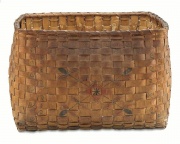Difference between revisions of "Laundry blue"
(username removed) |
|||
| Line 2: | Line 2: | ||
== Description == | == Description == | ||
| − | A fine particle, blue pigment used in washing white cotton and linen fabrics to counteract the yellowing caused by alkaline soaps. Laundry blue used in the late 18th to mid-19th century usually contained [ | + | A fine particle, blue pigment used in washing white cotton and linen fabrics to counteract the yellowing caused by alkaline soaps. Laundry blue used in the late 18th to mid-19th century usually contained [[Prussian%20blue|Prussian blue]] or [[indigo|indigo]]. Sometimes [[smalt|smalt]] was also used to whiten paper during this time. Reckitt's Blue, introduced in the 1850's, contained [[hultramarine%20blue%2C%20synthetic|synthetic ultramarine blue]]. It was sold in the form of a powder, block or coated on a sheet of paper. [[Starch|Starch]], [[gum%20arabic|gum arabic]], and/or [[carrageenan|carrageenan]] were used as a binders. In the early part of the 20th century, some water soluble synthetic dyes, such as [[methyl%20violet|methyl violet]], were introduced as blueing agents and optical brighteners. |
== Synonyms and Related Terms == | == Synonyms and Related Terms == | ||
Revision as of 11:49, 6 January 2014
Description
A fine particle, blue pigment used in washing white cotton and linen fabrics to counteract the yellowing caused by alkaline soaps. Laundry blue used in the late 18th to mid-19th century usually contained Prussian blue or Indigo. Sometimes Smalt was also used to whiten paper during this time. Reckitt's Blue, introduced in the 1850's, contained synthetic ultramarine blue. It was sold in the form of a powder, block or coated on a sheet of paper. Starch, Gum arabic, and/or Carrageenan were used as a binders. In the early part of the 20th century, some water soluble synthetic dyes, such as Methyl violet, were introduced as blueing agents and optical brighteners.
Synonyms and Related Terms
bluing agent; blauwsel (Ned); washing blue; blueing agent; Reckitt's Blue; Dolly Blue; Robin Blue; Bag Blue; Bleu de Bale
Additional Information
N.Odegaard, M. Crawford, "Laundry Bluing as a Colorant in Ethnographic Objects: ICOM Preprints 11th triennial meeting, Vol II, Edinburgh, 1996. G. Barton, S.Weik, ""Blue in the Pacific" SSCR Journal, Vol. 9 (4), 1998.
Authority
- Thomas Gregory, The Condensed Chemical Dictionary, Reinhold Publishing, New York, 3rd ed., 1942
- S.R.Trotman, E.R. Trotman, Textile Analysis, J.B. Lippincott Company, Philadelphia, 1932
- The Dictionary of Paper, American Paper Institute, New York, Fourth Edition, 1980
- E.J.LaBarre, Dictionary and Encyclopedia of Paper and Paper-making, Swets & Zeitlinger, Amsterdam, 1969
- The American Heritage Dictionary or Encarta, via Microsoft Bookshelf 98, Microsoft Corp., 1998
